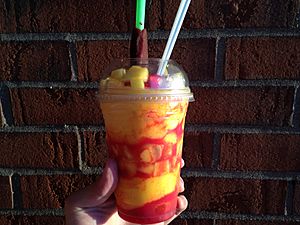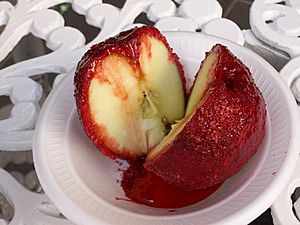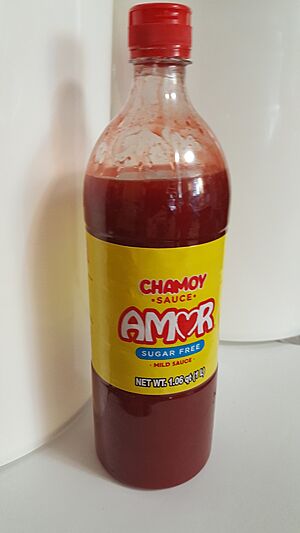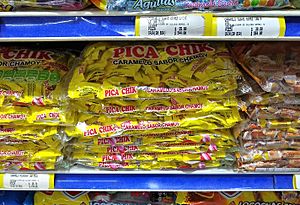Chamoy (sauce) facts for kids
Chamoy is a popular sauce and condiment from Mexican cuisine. It is made from pickled fruit. Chamoy can be thin like a liquid or thick like a paste. It usually tastes salty, sweet, sour, and spicy from chili peppers.
How Chamoy is Made
Mexican chamoy is made by first soaking fruit in a salty water mix called a brine. Sometimes, vinegar is added to this brine. The salty water pulls out the natural moisture from the fruit. When the fruit is dry enough, it is taken out of the brine. This dried fruit is then sold as a snack called saladitos, which means 'little salty things'.
The salty fruit water that is left over is then seasoned with chili powder. This liquid becomes chamoy. It can be cooked down to be thicker, or fruit puree can be added to make different textures.
The taste of chamoy can change a lot. This depends on the type of fruit used and what was in the salty brine. Most chamoy sauces are quite savory and spicy because of the chili powder. They are also salty from the brine. Depending on how much vinegar was used, chamoy can also be very sour or sweet.
Where Chamoy Comes From
No one is completely sure where chamoy first came from. But most people agree it started with Chinese snacks called crack seed. These snacks were made from dried, sour, and salty plums or berries.
One idea is that chamoy came to Mexico through Filipino people. They traveled on ships called the Manila galleons between the Philippines and Mexico from 1565 to 1815. Chamoy is likely related to a Filipino snack called champoy or kiamoy. These are also dried fruits pickled in salty water and vinegar. They taste sweet, sour, and salty, just like chamoy.
These Filipino snacks came from Chinese immigrants who brought li hing mui recipes to the Philippines. In the Philippines, champoy means the pickled fruit. But in Mexico, the word chamoy changed to mean the sauce made from pickling the fruit. The fruits themselves are now called saladitos.
Another idea is that chamoy came from Japanese umeboshi. This is a type of pickled plum. However, umeboshi is made differently, using only dry salt and no vinegar.
How People Use Chamoy

Many types of Mexican chamoy are sold in Mexico and parts of the American southwest. The thinner, more liquid chamoy is often sold in bottles, like hot sauces. Chamoy is a mix of salty, sweet, and spicy flavors. Because of this, it is used on many different foods. People put it on fresh fruit, juices, potato chips, and nuts. It is also a common ingredient in a street food called "tostilocos".
Thicker chamoy, which is more like a paste, is sometimes sold in small jars. This kind is good for dipping vegetables or firmer fruits. These jars are often sold next to other popular Mexican candies made from mango, tamarind, and watermelon. These candies are also often made in a salty and spicy style.
Chamoy is also used to flavor frozen treats. These include sorbet or raspados, which are like shaved ice. This creates a unique taste that is sweet, salty, spicy, and cold all at once. Raspados made this way are often called chamoyada. Paletas, which are Mexican ice pops, are also often made with chamoy. Popular flavors for both raspados and paletas include pineapple, cucumber, lime, mango, orange, tangerine, tamarind, and watermelon. Chamoy is also sometimes used to flavor Mexican candies.
The popular Mexican beer mix michelada is sometimes made with chamoy. It can be used instead of, or in addition to, the usual sauces.
See also
 In Spanish: Chamoy (salsa) para niños
In Spanish: Chamoy (salsa) para niños




